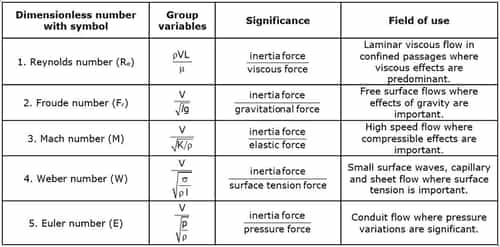INTRODUCTION
- It is used in research work and for conducting model tests.
- It deals with dimensions of physical quantities.
- All physical quantities are measured by comparison with length(L), Mass(M), Time(T)(These dimensions are called fundamental dimensions.)
Secondary Dimensions
They possess more than one fundamental dimension i.e. Velocity is LT-1

Dimensional Homogeneity
It means the dimensions of each term on both sides of the equation should be equal. Thus, if each term of any equation has the same dimensions on both sides, then it is known as the dimensionally homogenous equation.
METHODS OF DIMENSIONAL ANALYSIS
If the number of variables involved in a physical phenomenon are known, then relation among variables can be determined by two methods:
(1). Rayleigh method
(2). Buckingham -theorem
(1) Rayleigh Method
It is used to establish the relation for a variable which depends on three or more variables.
Let X be a variable which depends on X1, X2, X3 then, according to Rayleigh method
X=f (X1, X2, X3)
![]()
(2) Buckingham π- theorem
It defines that “Any problem having n variables and out of which m variables have primary dimensions (such as M, L, T) then equation establishing relation between all the variables will have (n-m) dimensionless groups”.
Buckingham referred to these groups as π groups and the equation containing these π groups can be written in the form of:
πl = f (π2, π3,……. πn-m)
- To solve the equation using this method there are two conditions taken into consideration:
(i). Each of the fundamental dimensions must be present in at least one of the m variables.
(ii). A dimensionless group must not be formed from one of the variables within a recurring set.
(iii). A recurring/repeating set is a group of variables which form a dimensionless group.
Method of selecting repeating variables:
In any problem, the number of repeating variables is same as the number of fundamental dimensions. The choice of repeating variables is chosen with the consideration of following points:
(a). The dependent variable should not be repeating variable
(b). The selection of repeating variable should be in such a manner that one of the variables should represent the geometric property, other should be flow property and third variable should be fluid property.
Variables with geometric property
(i) Length(L) ii) diameter(d) iii) height etc.
Variables with flow property
(i) Velocity(v) ii) acceleration etc.
Variables with fluid property
(i) Dynamic viscosity (μ) ii) density (ρ) etc.
VARIOUS FORCES IN FLUID MECHANICS
1. Inertia force (Fi): It is defined as the product of mass and acceleration of the flowing fluid and acts in such a direction that it opposes the acceleration.
Fi = ρL2V2
2. Surface tension force (Fs): It is defined as the product of surface tension and length of surface of the flowing fluid.
Fs =σ L
3. Gravity force (Fg): It is defined as the product of mass and acceleration resulting from the gravity of the flowing fluid.
Fg = ρl3g
4. Pressure force (FP): It is equal to the product of pressure intensity and cross-sectional area of the flowing fluid.
FP = P × A ⟹ FP = PL2
5. Viscous force (Fv): It is defined as the product of shear stress (τ) resulting from viscosity and surface area (As) of the flow.
Fv = μLv
6. Elastic force (Fe): It is defined as the product of elastic stress and area (A) of the flowing fluid.
Fe = KL2

SIMILITUDE & MODELING
- Geometric similarity: if the ratio of corresponding dimensions of model & Prototype are same.

- For kinematic similarity, Geometric Similarity is mandatory.

- For dynamic similarity, geometric and kinematic similarities are mandatory.

Reynold’s Model Law:

Froude’s Model Law:

Euler’s model law:

Weber model law:

Mach Model Law:

Undistorted Models:
- The models which are geometrically similar to their prototypes are called Undistorted models. In other words, the same scale ratio is taken for the linear dimensions of the model and its prototype.
Distorted Models:
- If a model is not geometrically similar to its prototype, then it is a distorted model.
- in distorted models, different scale ratios are taken for linear dimensions i.e. different scale ratios are preferred for horizontal and vertical dimensions.
- Example: For the rivers, reservoirs etc., two different scale ratios are taken: one for horizontal dimensions and other for vertical dimensions.
You can avail of BYJU’S Exam Prep Online classroom program for all AE & JE Exams:
BYJU’S Exam Prep Online Classroom Program for AE & JE Exams (12+ Structured LIVE Courses)
You can avail of BYJU’S Exam Prep Test series specially designed for all AE & JE Exams:
BYJU’S Exam Prep Test Series AE & JE Get Unlimited Access to all (160+ Mock Tests)
Thanks
Team BYJU’S Exam Prep
Download BYJU’S Exam Prep APP, for the best Exam Preparation, Free Mock tests, Live Classes.




Comments
write a comment